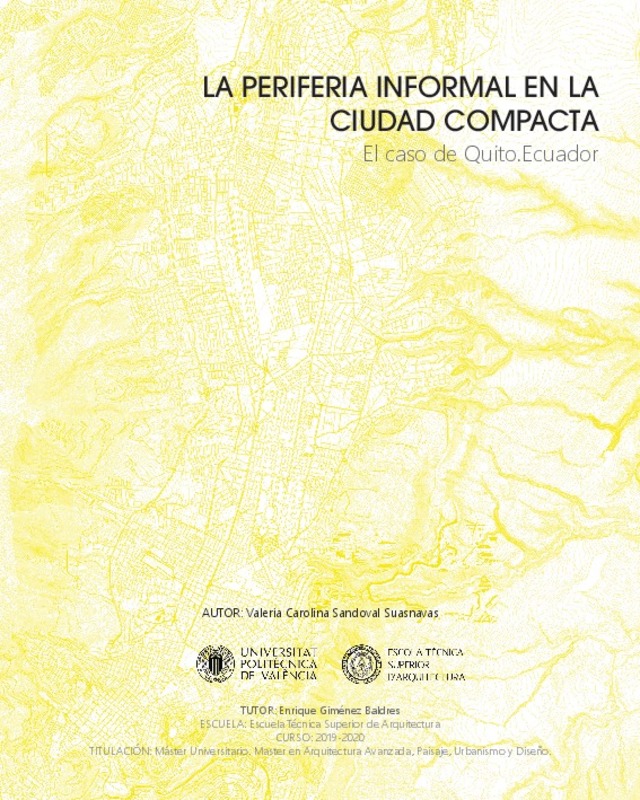|
Resumen:
|
[ES] La configuración actual de las ciudades latinoamericanas surge del acelerado proceso de expansión del territorio urbano que tuvo lugar en las décadas centrales del siglo XX. Dentro de este panorama, en varias metrópolis, ...[+]
[ES] La configuración actual de las ciudades latinoamericanas surge del acelerado proceso de expansión del territorio urbano que tuvo lugar en las décadas centrales del siglo XX. Dentro de este panorama, en varias metrópolis, dicho proceso ha conllevado a la aparición de asentamientos informales estructurados en su mayoría dentro de la periferia. En este trabajo, se estudiará este elemento del territorio, al cual denominaremos “periferia informal”. Se detallará su desvinculación con la estructura territorial urbana perteneciente a la ciudad canónica y su posible integración a través de estrategias de intervención ligadas a aspectos estructurales de accesibilidad. Partiendo de la recopilación de asentamientos informales en la periferia de varias ciudades latinoamericanas, el estudio se centra en la ciudad de Quito, capital del Ecuador. Se realizará una descripción del crecimiento urbano y de su infraestructura vial. El objetivo será de entender el proceso y las posibles causas de la concepción de la periferia informal. Se discutirá sobre aspectos estructurales ligados a la accesibilidad que son prioritarios a la hora de mejorar la integración de la periferia informal a la ciudad compacta. Paralelamente se tomará como casos de estudio tres modelos de ciudades latinoamericanas, que a diferentes escalas y con diferentes propósitos, han sabido generar acciones de accesibilidad a través de actuaciones estratégicas en su tejido urbano: Medellín (Colombia), Curitiba y Sao Paulo (Brasil). Para comenzar el estudio presentará una comparación de las soluciones planteadas a este fenómeno dentro de Latinoamérica. Se continuará con el relato del crecimiento del tejido urbano de Quito seguido de la lectura de la evolución de las infraestructuras de transporte y de conectividad. Estos elementos serán la base para el entendimiento de la aparición de los asentamientos informales. Finalmente, la investigación remata con el estudio pormenorizado de la franja noroccidental de la cuidad de Quito y más específicamente del barrio de “Atucucho”. A través de la correlación de actuaciones estructurales sectoriales y actuaciones puntuales estratégicas que buscan otorgarle una nueva oportunidad a la informalidad, se plantea la definición de una actuación estratégica para la unión del tejido urbano de la periferia informal y la ciudad canónica.
[-]
[EN] The current configuration of several Latin American cities is a direct consequence of the accelerated process of urban expansion in the territory that took place in the central decades of the 20th century. In this ...[+]
[EN] The current configuration of several Latin American cities is a direct consequence of the accelerated process of urban expansion in the territory that took place in the central decades of the 20th century. In this panorama, this process has led to the creation of informal settlements, usually located on the periphery. Thus, in this work will be focused in the study of the territory, called ¿informal periphery¿, specifying its disconnection with the urban structure and its possible integration through intervention strategies linked to structural aspects of accessibility.
Based on a compilation of examples of informal periphery in Latin American cities, the study focuses on the city of Quito, capital of Ecuador. A description of its urban growth and road infrastructure is made with the aim of understanding the development and the possible reasons of the conception of the informal periphery in its urban structure. Thus, it is established that actions on structural aspects linked to accessibility are priorities when it comes to improve the integration of the informal periphery into the compact city. At the same time, we will include three Latin American cities as study cases, which at different scales and with different purposes have managed to generate accessibility approaches through strategic actions within their urban fabric: Curitiba, Sao Paulo (Brazil) and Medellin (Colombia).
Frist of all the study will present a comparison of the solutions proposed to this phenomenon within Latin America. We will continue with a approach of the growth of the urban fabric of Quito followed by the reading of the evolution of transport and connectivity infrastructures. These elements will be the basis for understanding the emergence of informal settlements. Finally, the investigation ends with a detailed study of the northwestern strip of the caretaker of Quito and more specifically of the ¿Atucucho¿ neighborhood. Through the correlation of sectoral structural actions and specific strategic actions that seek to give informality a new opportunity, the definition of a strategic action for the union of the urban fabric of the informal periphery and the canonical city is proposed.
[-]
|







